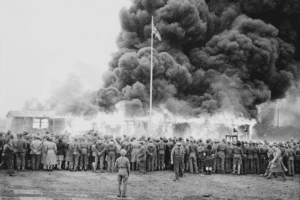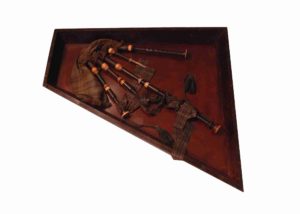
A Charred Memory: A Fragment of Bergen-Belsen at The Black Watch Museum
As the Collections Assistant at The Black Watch Museum, I spend my days surrounded by conflict-related artefacts such as medals, uniforms, letters, and photographs that
Home » Blog » Illuminating Objects » The Fairbairn-Sykes Fighting Knife

 As a Regimental Museum it is difficult, when wandering around the store, to avoid the occasional sharp, pointy thing, which always seem to be either at head, or elbow, level. All of us who work with the objects in storage have a story to tell about a particular item that is always ‘out to get them.’ In the case of my Collections Assistant colleague it is the item that I am blogging about today.
As a Regimental Museum it is difficult, when wandering around the store, to avoid the occasional sharp, pointy thing, which always seem to be either at head, or elbow, level. All of us who work with the objects in storage have a story to tell about a particular item that is always ‘out to get them.’ In the case of my Collections Assistant colleague it is the item that I am blogging about today.
The Royal Marine Commando Knife, officially known as the Fairbairn-Sykes Fighting Knife was invented in Shanghai in the 1930s by the aforementioned William Ewart Fairbairn and Eric Anthony Sykes, both of whom were members of the Shanghai Military Police. During their time in that police force both men, but in particular Fairbairn, found themselves involved in street fights with local gangs. As a result of this they developed a style of self-defence based on a variety of martial arts, as well as other skills such as pistol and knife fighting.
It is this last that led to the development of what has been described as one of the most perfect, silent, killing weapons ever devised. Specifically designed for surprise attacks, the blade is narrow, almost like a stiletto, so that it can slip between the ribs, and the handle is deliberately roughened so that it can still be held when wet with blood. The length of the blade was chosen to allow several inches for killing after having penetrated the thickest military clothing of the time, a soviet greatcoat. Having discussed these requirements with the Wilkinson Sword Company in November 1940, the first batch of fighting knives were delivered in January 1941.
The creation of this knife greatly interested the various services that sprang up during the Second World War, dealing with covert activities and raiding. In 1940 Fairburn and Sykes were recruited by the British Secret Service and began training members of the OSS (Office for Strategic Services, the forerunner of the CIA, who specialised in covert activities and espionage behind enemy lines), the various allied commando units, and the US Rangers.
The term gutter fighting was coined by Fairburn to describe his and his friend’s style of fighting, and is best summed up by the man himself. “Get tough, get down in the gutter, win at all costs… There’s no fair play, no rules except one: kill or be killed.”
By 1942 stresses began to appear in the friendship between Fairbairn and Sykes and the two parted company, never to meet again. Fairbairn went off to Canada to train Special Forces operatives over there, and finished the war as a Lieutenant Colonel. Sykes on the other hand continued teaching in Britain, mainly to members of the SOE (Special Operations Executive, the British equivalent of the OSS) until he was forced to relinquish his commission due to disability. He died on the 12th May 1945 at Bexhill-on-Sea.
The weapon that they jointly designed though proved to be both very popular and enduring. Over two million were produced in Britain alone, pattern was copied the world over, and is still in use today.
Richard MacKenzie, The Black Watch Museum archivist

As the Collections Assistant at The Black Watch Museum, I spend my days surrounded by conflict-related artefacts such as medals, uniforms, letters, and photographs that
Just before heading up the stairs to Gallery 4 visitors will see the painting of someone who, on first glance, might not look like a

Rosie Waine is the William Grant Foundation Research Fellow at the National Museum of Scotland. Here she writes how the Black Watch Museum & Castle
Subscribe to Our Newsletter
© The Black Watch Castle and Museum
The Black Watch Regimental Trust is a charitable company registered in Scotland | Charity No: SC005848
